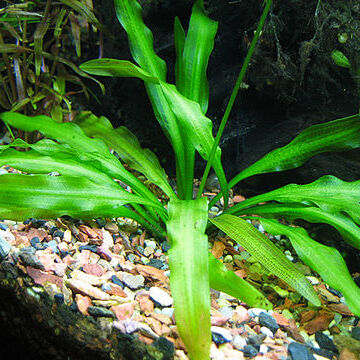Tuber globular, obovoid, or elongate, 6-25 mm ø, smooth. Submerged leaves 10-25 by ¾-4¼ cm, alternately transparent or opaque in an irregular pattern; base (narrowly) cuneate or rounded, apex (narrowly) cuneate or rounded, seldom emarginate, tip blunt; margin undulate, midrib wide with (2-)3(-4) main nerves on either side; petiole 10-35 cm. Floating leaves rather rare, up to 20 by 3½ cm; base rounded or cordate, apex cuneate with a blunt tip; main nerves 5 or 7; petiole up to 70 cm. Peduncle up to 55 cm, thickening towards the inflorescence. Spathe up to 17 mm, persistent or caducous. Spike up to 10 cm, laxly flowered. Tepals (1-)2(-3), caducous, spathulate or obovate, 1(-2-3)-nerved, white or pinkish, (2-)3½-6(-12) by 1-2½(-4) mm. Filaments slightly widening towards the base, white or pinkish; anthers light yellow, pollen yellow. Ovaries 3(-4), light pink, 1¼-2 by ½-1 mm; ovules 2. Infructescence up to 16 cm. Fruit 5-7 by 4 mm with a short, terminal, curved beak. Seeds with a simple testa; embryo up to 5 by 2 mm; plumule attached near the base of the embryo and lying in a very wide groove. Runners resembling peduncles, ascending, up to 35 cm, not or slightly thickened towards the tip. The plantlet is developed at the tip of the runner, in an early stage it is enveloped by a persistent spathe of up to 20 mm. The young plant itself may also put forth one or two short runners, and by repeating this up to 7 plantlets may be produced.
More
A plant which grows in water and keeps growing from year to year. The underground stem is branched. It can be 2.5 cm across. The leaves can be under water or floating. They have long stalks and can be 10-25 cm long by 1-4 cm wide. The edges are wavy. The leaves have patches which let light through. The plant produces runners with young plantlets are the end. The flowers are on a long stalk.


